The Evolution of the Promise of Hair Cloning: How Hair Cell Cloning Will Fit Into Your Practice
March 2022
in “Hair transplant forum international”
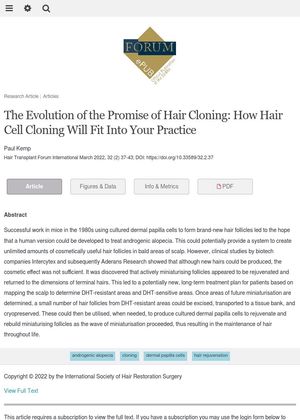
TLDR Hair cell cloning could potentially rejuvenate shrinking hair follicles, allowing for lifelong hair maintenance.
Research in the 1980s showed that cultured dermal papilla cells could form new hair follicles in mice, leading to hopes of a similar treatment for human androgenic alopecia. However, clinical studies by Intercytex and Aderans Research found that while new hairs could be produced, the cosmetic effect was insufficient. Instead, it was found that actively miniaturising follicles could be rejuvenated and returned to the size of terminal hairs. This led to a potential new treatment plan based on mapping the scalp to identify DHT-resistant and DHT-sensitive areas. Hair follicles from DHT-resistant areas could be excised, transported to a tissue bank, and cryopreserved. These could then be used to produce cultured dermal papilla cells to rejuvenate and rebuild miniaturising follicles, maintaining hair throughout life.
View this study on ishrs-htforum.org →
Cited in this study
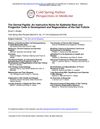
research The Dermal Papilla: An Instructive Niche for Epithelial Stem and Progenitor Cells in Development and Regeneration of the Hair Follicle
The dermal papilla is crucial for hair growth and health, and understanding it could lead to new hair loss treatments.
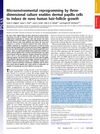
research Microenvironmental reprogramming by three-dimensional culture enables dermal papilla cells to induce de novo human hair-follicle growth
Growing human skin cells in a 3D environment can stimulate new hair growth.
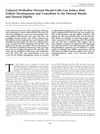
research Cultured Peribulbar Dermal Sheath Cells Can Induce Hair Follicle Development and Contribute to the Dermal Sheath and Dermal Papilla
Certain cells from hair follicles can create new hair and contribute to hair growth when implanted in mice.
Related

research The Evolution of the Promise of Hair Cloning: How Hair Cell Cloning Will Fit Into Your Practice
Hair cell cloning could potentially rejuvenate shrinking hair follicles, allowing for lifelong hair maintenance.
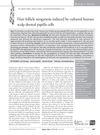
research Hair follicle neogenesis induced by cultured human scalp dermal papilla cells
Scientists found a way to grow human hair cells in a lab that can create new hair when transplanted.
![[Hair follicle cell mixture forms hair follicle-like structures after subcutaneous implantation in nude mice].](/images/research/ea08e7ee-b88a-4899-aeb3-8bce4a8567c8/small/19967.jpg)
research [Hair follicle cell mixture forms hair follicle-like structures after subcutaneous implantation in nude mice].
Implanted human scalp cells can regenerate hair-like structures in mice.

research Quantitative study of the human hair follicle in normal scalp and androgenetic alopecia
Alopecia causes smaller hair follicles and affects growth-related structures.
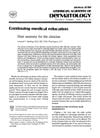
research Hair anatomy for the clinician
Understanding hair follicle anatomy helps diagnose hair disorders.